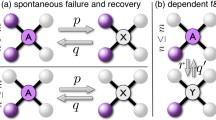Abstract
The simultaneous unavailability of several technical components within large-scale engineering systems can lead to high stress, rendering them prone to cascading events. In order to gain qualitative insights into the failure propagation mechanisms resulting from independent outages, we adopt a minimalistic model representing the components and their interdependencies by an undirected, unweighted network. The failure dynamics are modeled by an anticipated accelerated “wearout” process being dependent on the initial degree of a node and on the number of failed nearest neighbors. The results of the stochastic simulations imply that the influence of the network topology on the speed of the cascade highly depends on how the number of failed nearest neighbors shortens the life expectancy of a node. As a formal description of the decaying networks we propose a continuous-time mean field approximation, estimating the average failure rate of the nearest neighbors of a node based on the degree-degree distribution.
Access this chapter
Tax calculation will be finalised at checkout
Purchases are for personal use only
Preview
Unable to display preview. Download preview PDF.
Similar content being viewed by others
References
Gheorghe, A.V., Masera, M., Weijnen, M., De Vries, L.: Critical Infrastructures at Risk - Securing the European Electric Power System. Springer, Dordrecht (2006)
Sachtjen, M.L., Carreras, B.A., Lynch, V.E.: Disturbances in a power transmission system. Phys. Rev. E 61, 4877–4882 (2000)
Albert, R., Albert, I., Nakarado, G.L.: Structural vulnerability of the North American power grid. Phys. Rev. E 69, 025103 (2004)
Holmgren, A.J.: Using graph models to analyze the vulnerability of electric power networks. Risk Analysis 26(4), 955–969 (2006)
Motter, A.E., Lai, Y.C.: Cascade-based attacks on complex networks. Phys. Rev. E 66, 065102 (2002)
Motter, A.E.: Cascade control and defense in complex networks. Phys. Rev. Lett. 93, 098701 (2004)
Crucitti, P., Latora, V., Marchiori, M.: Model for cascading failures in complex networks. Phys. Rev. E 69, 045104 (2004)
Simonsen, I., Buzna, L., Peters, K., Bornholdt, S., Helbing, D.: Transient dynamics increasing network vulnerability to cascading failures. Phys. Rev. Lett. 100, 218701 (2008)
Albert, R., Jeong, A.L.H., Barabási, A.L.: Error and attack tolerance of complex networks. Nature 406, 378–382 (2000)
Schläpfer, M., Dietz, S., Kaegi, M.: Stress induced degradation dynamics in complex networks. In: Proceedings of the International Conference on Infrastructure Systems. IEEE, Los Alamitos (2008)
Dorogovtsev, S.N., Mendes, J.F.F.: Evolution of networks: From biological nets to the internet and WWW. Oxford University Press, Oxford (2003)
Birolini, A.: Reliability Engineering, Theory and Practice, 5th edn. Springer, Berlin (2007)
Erdős, P., Rényi, A.: On random graphs. Publ. Math. Debrecen 6, 290–297 (1959)
Barabási, A.-L., Albert, R.: Emergence of scaling in random networks. Science 286, 509–512 (1999)
Taylor, A., Higham, D.J.: CONTEST: A controllable test matrix toolbox for MATLAB. University of Strathclyde Mathematics Research Report 13 (2007)
Smith, D.M.D., Lee, C.F., Onnela, J., Johnson, N.F.: Link-space formalism for network analysis. Phys. Rev. E 77, 036112 (2008)
Matlab, The Language of Technical Computing, Version R2008a
Author information
Authors and Affiliations
Editor information
Editors and Affiliations
Rights and permissions
Copyright information
© 2009 ICST Institute for Computer Science, Social Informatics and Telecommunications Engineering
About this paper
Cite this paper
Schläpfer, M., Shapiro, J.L. (2009). Modeling Failure Propagation in Large-Scale Engineering Networks. In: Zhou, J. (eds) Complex Sciences. Complex 2009. Lecture Notes of the Institute for Computer Sciences, Social Informatics and Telecommunications Engineering, vol 5. Springer, Berlin, Heidelberg. https://doi.org/10.1007/978-3-642-02469-6_89
Download citation
DOI: https://doi.org/10.1007/978-3-642-02469-6_89
Publisher Name: Springer, Berlin, Heidelberg
Print ISBN: 978-3-642-02468-9
Online ISBN: 978-3-642-02469-6
eBook Packages: Computer ScienceComputer Science (R0)




